VIRTUAL ITALIAN ORGANS
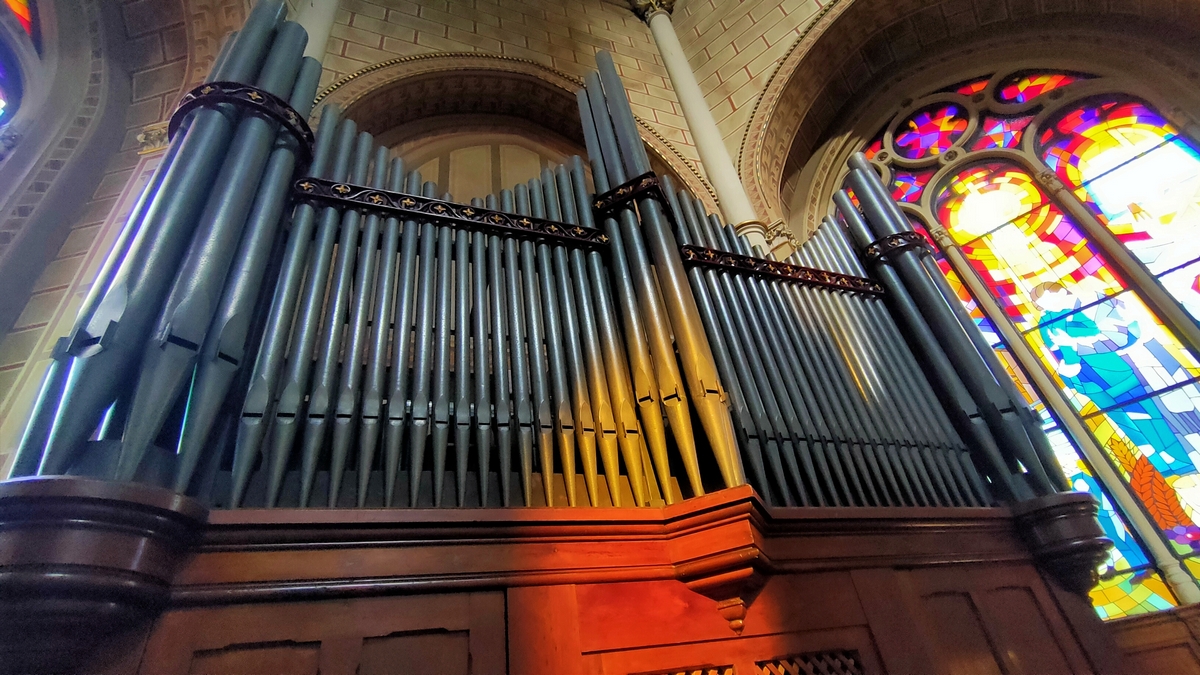
Located in one of the most characteristic areas of the city of Milan and directly overlooking the Alzaia del Naviglio Grande, near the Darsena di Porta Genova, the church of Santa Maria delle Grazie al Naviglio - so called to distinguish it from the Gothic-Renaissance one on Corso Magenta, much better known as it houses the famous fresco of Leonardo's Last Supper - it was built between 1901 and 1909, designed by the Milanese architect Cesare Nava.
The devotion to the Virgin Mary in this place is documented as early as 1556 with the construction of a chapel in which a miraculous image of the Virgin was placed, in its place then a larger baroque style church was built.
In 1719 a fire seriously damaged the church, which was restored; in 1849 it was elevated to a parish. At the end of the nineteenth century, the increase in population led to the church being rebuilt again, with dimensions adequate for a rapidly growing number of faithful.
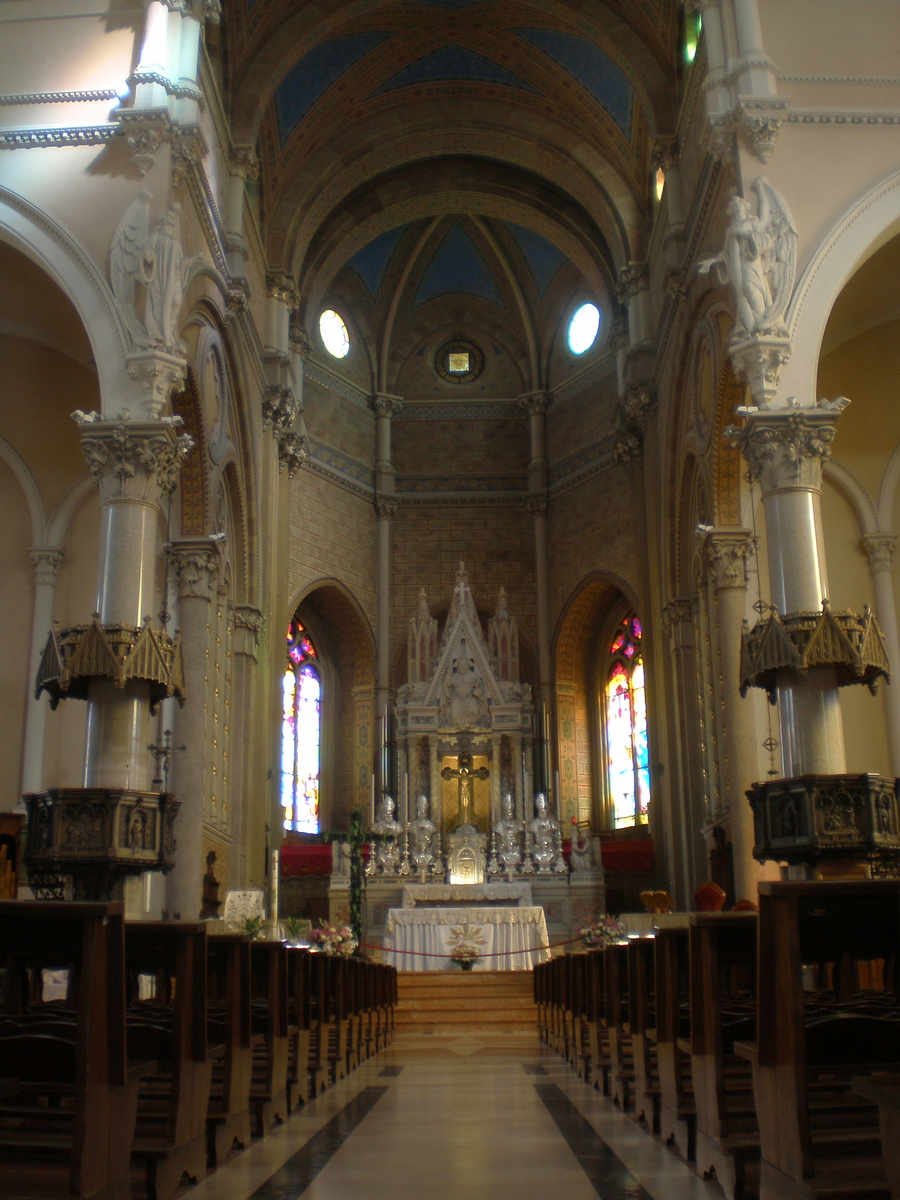
The current sacred building still preserves some works coming in particular from the eighteenth-century church, such as the splendid sculptural group of the Pietą originally placed on the main altar of the old baroque church and today in the left transept.
The temple in eclectic-neo-Gothic style, in the shape of a Latin cross with a lantern at the intersection of the arms, is of imposing dimensions: the main nave is approximately 60 meters long for a height of approximately 25. The external facades remained unfinished, without the ornamentation foreseen by the project: the main facade, which overlooks directly on the Naviglio Grande, was subjected to a cleaning operation in recent years.
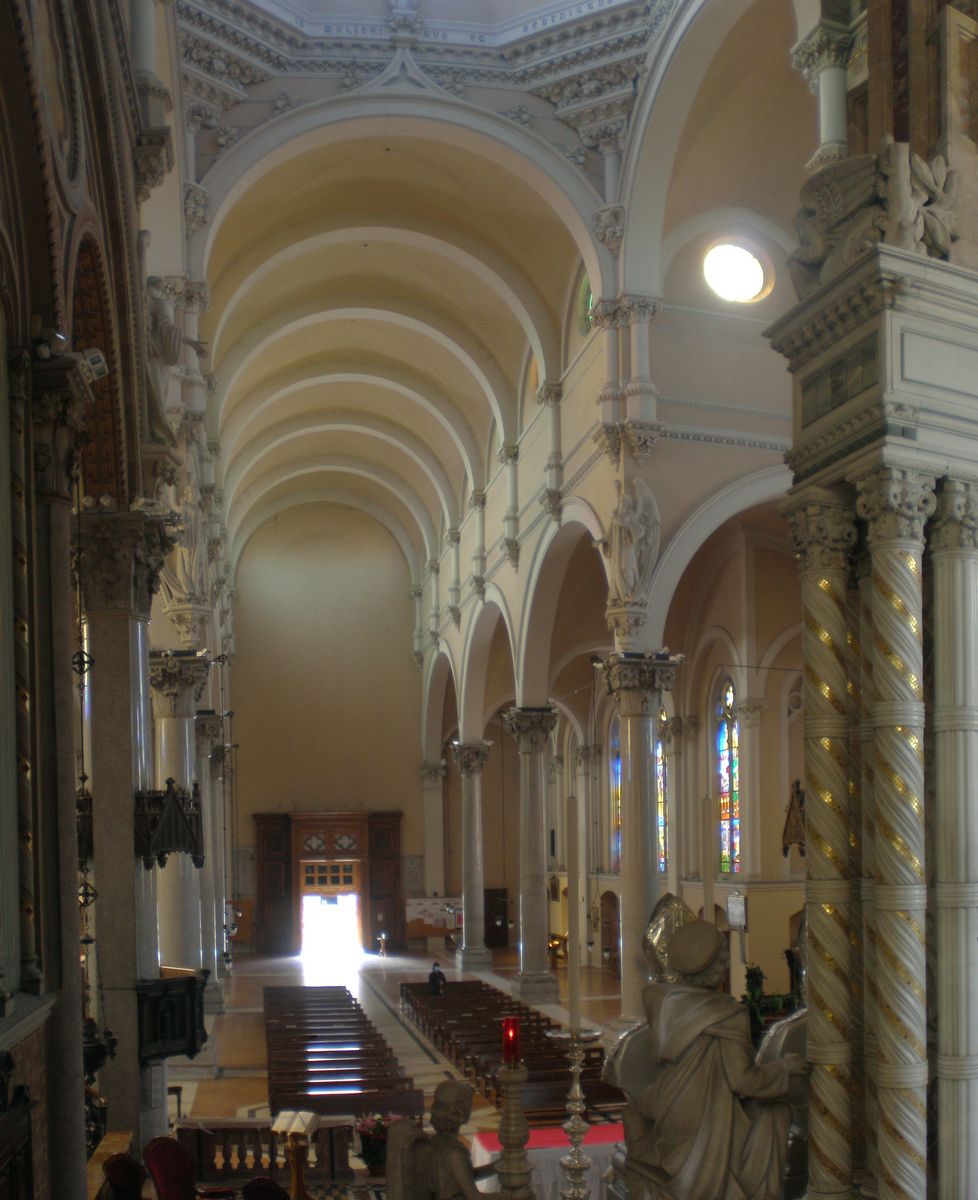
The bell tower, set behind the apse, is 59 meters high and houses a good peal of 5 bells in D flat.
Behind the imposing main altar there is a masonry choir loft which includes the entire width of the apse: in the center of this is the organ.
Here more information on the church of Santa Maria delle Grazie al Naviglio.
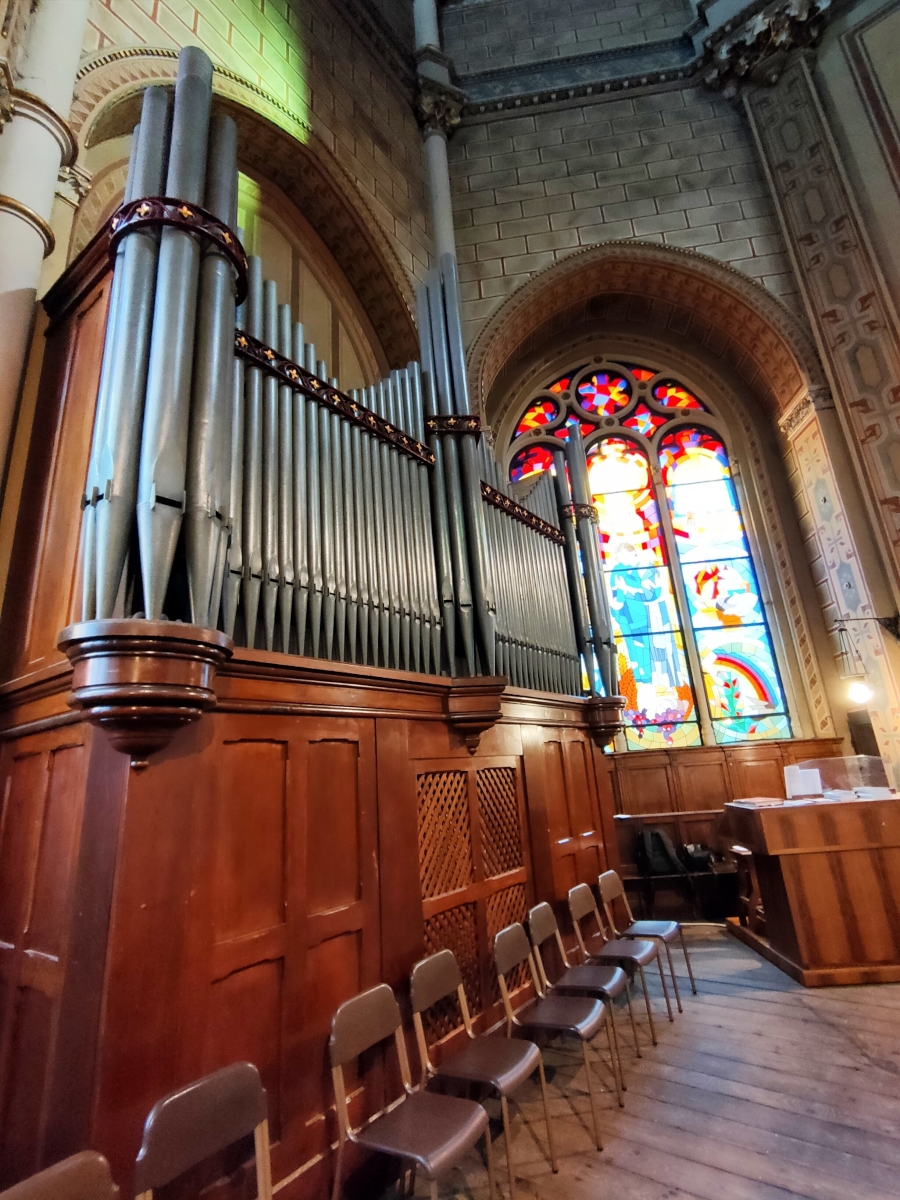 The organ of S. Maria delle Grazie al Naviglio was built by Daniele Michelotto in 2020, partially reusing the materials of a late nineteenth-century English instrument, integrated with new stops.
The organ of S. Maria delle Grazie al Naviglio was built by Daniele Michelotto in 2020, partially reusing the materials of a late nineteenth-century English instrument, integrated with new stops.
The instrument was strongly desired by the then parish priest Don Marcello Barlassina, to replace a previous organ from 1905 by Edoardo Rossi which had been heavily remodelled, inefficient for decades and too small in size for the imposing sacred building.
The sound project is by M° Paolo Oreni and the stylistic one by M° Roberto Lomurno, current owner: the organ presents itself as an eclectic instrument, with stops with very well characterized personality and with very original solutions in sound design which allow to obtain, despite a relatively small number of pipes, the same performance as a medium-large symphonic instrument.
Moveable console with three 61-note keyboards and 32-note pedalboard.
Stops with pivot plate in two panels on the sides of the manuals.
| POSITIVO | GRAND'ORGANO | RECITATIVO | PEDALE |
| FLAUTO 8' | BORDONE 16' | FLAUTO ARMONICO 8' | SUBBASSO 32' |
| BORDONE 8' | DIAPASON 8' | GAMBA 8' | CONTRABBASSO 16' |
| FLAUTO CAMINO 4' | GRAN FLAUTO 8' | VOCE CELESTE 8' | SUBBASSO 16' |
| NAZARDO 2'2/3 | BORDONE 8' | FLAUTO OTTAVIANTE 4' | BASSO 8' |
| FLAUTINO 2' | PRESTANTE 4' | FUGARA 4' | BORDONE 8' |
| TERZA 1'3/5 | GRAN TERZA 3'1/5 | OTTAVINO ARMONICO 2' | FLAUTO 4' |
| LARIGOT 1'1/3 | QUINTA 2'2/3 | PICCOLO ARMONICO 1' | FLAUTINO 2' |
| SETTIMA 1'1/7 | GRAN SETTIMA 2'2/7 | CARILLON III | TIORBA III |
| ALIQUOT | DOUBLETTE 2' | FAGOTTO 16' | CONTROBOMBARDA 32' |
| RANQUETTE 16' | MIXTURE 2'2/3 | TROMBA ARMONICA 8' | BOMBARDA 16' |
| CLARINETTO 8' | PLEIN JEUX 2' | OBOE 8' | CONTROFAGOTTO 16' (DA RECIT.) |
| TREMOLO GO/POS | CORNETTO II-V | CLARONE ARMONICO 4' | RANQUETTE 16' |
| TROMBA 16' | TREMOLO | TROMBA 8' | |
| TROMBA 8' | FAGOTTO 8' (DA RECIT.) | ||
| TREMOLO GO/POS | CLARONE 4' | ||
| CLARINETTO 4' |
Couplings and accessories:
| UNIONI | AGGIUSTABILI | PISTONI | ALTRI ACCESSORI |
| POS./G.O. | F | REC. AL POS. | SPLIT PEDALE |
| REC./G.O. | - | REC. AL G.O. | PIANO AUT. PEDALE |
| REC./POS. | 1 | POS. AL G.O. | SOSTEN. G.O. |
| POS./PED. | 2 | REC. AL PED. | SOSTEN. POS. |
| G.O./PED. | 3 | G.O. AL PED. | SOSTEN. REC. |
| REC./PED. | 4 | POS. AL PED. | SOSTEN. PED. |
| REC./16'/POS. | 5 | - | BASSI G.O. |
| REC./16'/G.O. | 6 | + | BASSI POS. |
| REC./16'/REC. | 7 | FONDI 16' | BASSI REC. |
| ANN. UNISONO REC. | 8 | FONDI 8' | SOPRANI POS./G.O. |
| POS./4'/PED. | 9 | FONDI 4' | SOPRANI REC./G.O. |
| G.O./4'/PED. | 10 | PLENUM | SOPRANI REC./POS. |
| REC./4'/PED. | + | FORTE GENERALE | INVERTITORE G.O./POS. |
| A | ANCE REC. | + CRESC. | |
| 100 memory banks | ANCE POS. | ASS. CRESC. | |
| 10 general combinations | ANCE G.O. | TRASPOSITORE + | |
| ANCE PED. | TRASPOSITORE - | ||
| AGGIUSTABILI -- | |||
| AGGIUSTABILI ++ | |||
| AGGIUSTABILI - | |||
| AGGIUSTABILI + | |||
| SPLIT POINT |
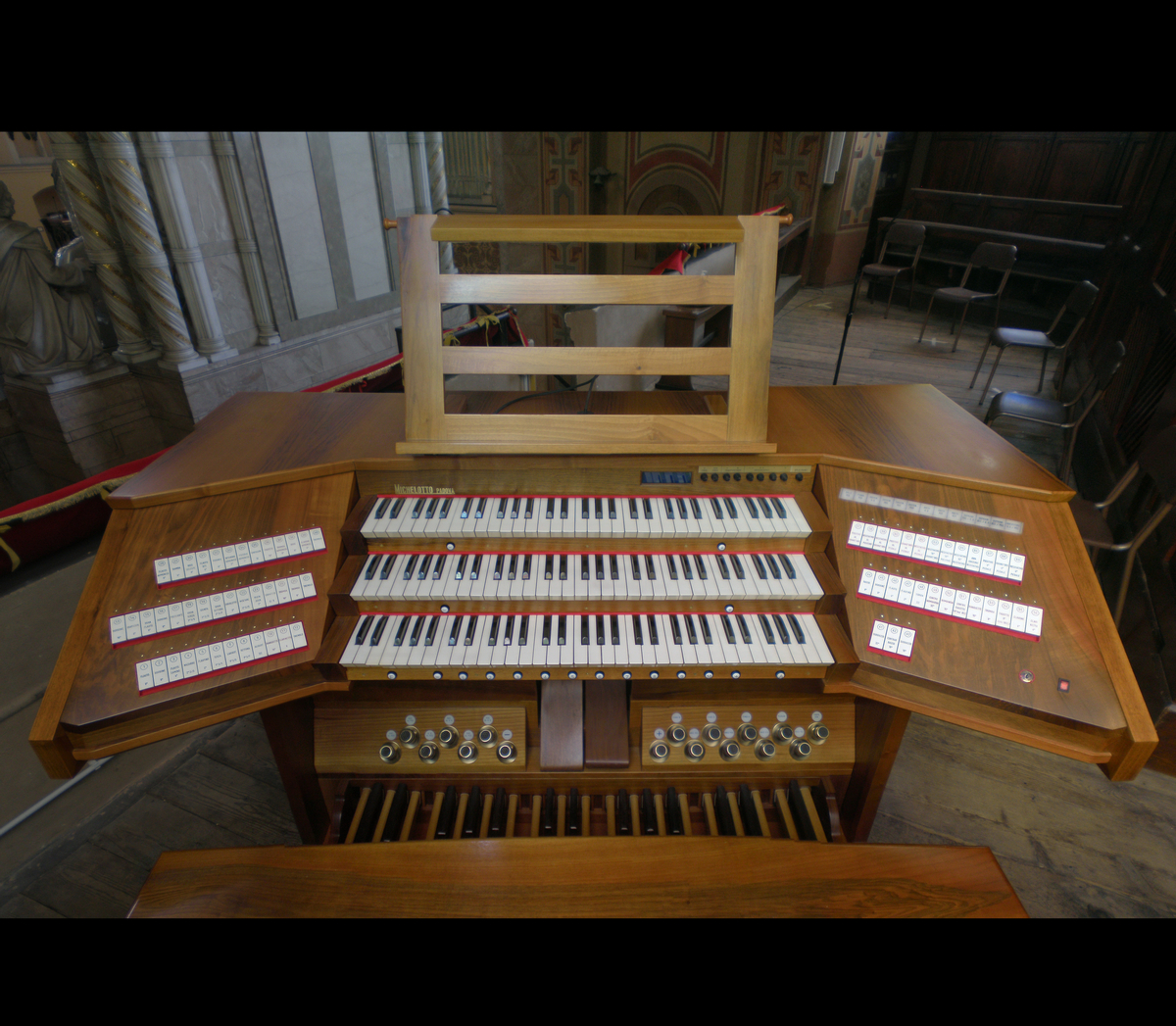 Positivo, Aliquot: 3 ranks 5'1/3, 3'1/5 and 2'2/7 (Fifth, Third and Seventh on 16' basis)
Positivo, Aliquot: 3 ranks 5'1/3, 3'1/5 and 2'2/7 (Fifth, Third and Seventh on 16' basis)
Recitativo, Carillon: 3 ranks 2'2/3, 1'3/5 (from C25) and 1'
Pedale, Tiorba: 3 ranks 6'2/5, 4'4/7 and 3'5/9 (Third, Seventh and Ninth on 32' basis)
Nine programmable memories for Crescendo (ten steps), assignable via the ASS. CRESC. command.
Alphanumeric display above the III manual with indications for the status of Crescendo and related memory banks, Expression, Combinations and related memory banks, Transposer (-4/+3 semitones).
SPLIT PEDALE: divides the pedal board into two halves. In the low half only the Pedale stops sound while in the high half only the unions from the manuals (if inserted). The split point is set using the SPLIT POINT button, pressing the desired pedal, and is kept in memory every time SPLIT PEDALE is activated.
PIANO AUTOMATICO AL PEDALE: when playing on the Positivo and Recitativo keyboards it excludes all the stops and unions of the Pedal except Subbasso 16', Bordone 8' and REC/PED coupler (if inserted).
SOSTENUTO: available for Grand'Organo, Positivo, Recitativo and Pedale. It keeps all the notes played active, adding them progressively, as long as it remains enabled.
BASSI to Grand'organo, to Positivo and to Recitativo: monophonic union of the Pedale to the selected manual keyboard. The lowest note played will also make the Pedal stops heard.
SOPRANI between the various keyboards: monophonic union between the selected keyboard and the one being played on. The higher note will also make the stops of the coupled keyboard heard.
STOPS LIST: CHARACTERISTICS AND PARTICULARITY
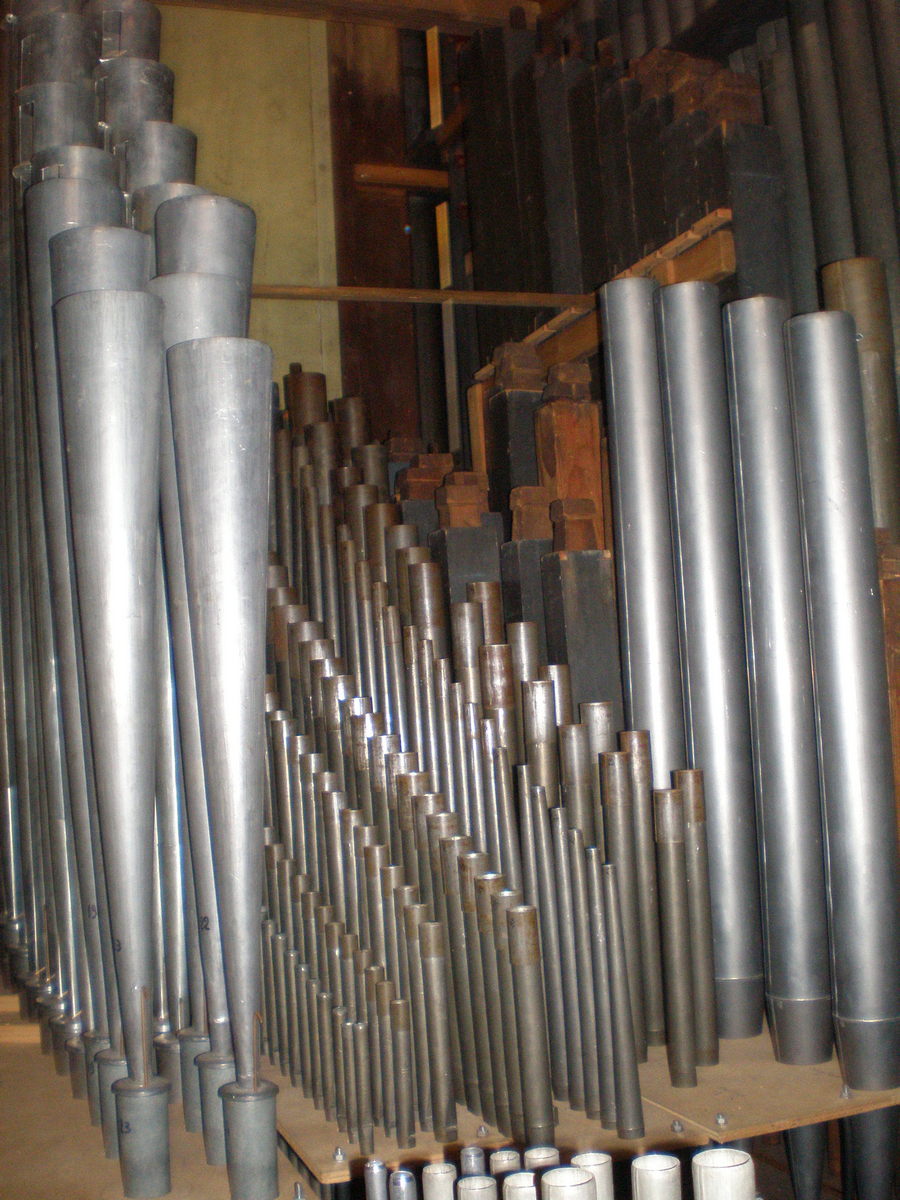 The Michelotto organ, as we have mentioned, makes an intelligent and massive use of borrowing according to a very articulated and complex scheme which - together with the strong personality of the real stops - allows us to obtain a particularly rich and versatile stops list. The downside is the need to carefully prepare the stop combinations, looking each time for those that lead to the desired tonal and dynamic balance.
The Michelotto organ, as we have mentioned, makes an intelligent and massive use of borrowing according to a very articulated and complex scheme which - together with the strong personality of the real stops - allows us to obtain a particularly rich and versatile stops list. The downside is the need to carefully prepare the stop combinations, looking each time for those that lead to the desired tonal and dynamic balance.
Despite its complexity, we still give the scheme of the derivations that make up the stops list, with very particular solutions such as the acoustic effect of the Controbombarda 32' obtained by making the Bordone 16' produce the odd harmonics or the peculiar arrangement of the Mixtur (with exceptionally low breaking) and the Aliquot (Positivo) and Tiorba (Pedale) stops.
BORDONE 16', 96 pipes (C#1-C97):
Positivo: Bordone 8', Flauto Camino 4', Flautino 2', Aliquot (rank in 5'1/3 C1-B12)
Grand'Organo: Bordone 16' (C#2-C61), Bordone 8', Cornetto II-V (ranks in 8' e in 4': F18-C61; rank in 2': C13-C61)
Pedale: Subbasso 32' (rank in 10'2/3, C1-B12), Tiorba (3 ranks in 6'2/5, 4'4/7, 3' 5/9), Controbombarda 32' (ranks di rinforzo in 10'2/3, 6'2/5, 4'4/7: C1-B12)
DIAPASON 8', 85 pipes (C1-C85):
Grand'Organo: Diapason 8', Prestante 4', Doublette 2', Mixture 2'2/3 (rank in 4': A22-C61; rank in 8': D27-C61; rank in 16': E41-C61)
GRAN FLAUTO 8', 61 pipes (C1-C61):
Positivo: Flauto 8'
Grand'organo: Gran Flauto 8'
Pedale: Flauto 4', Flautino 2'
GRAN TERZA 3'1/5, 73 pipes (C1-C73):
Positivo: Terza 1'3/5; Aliquot (rank in 3'1/5)
Grand'Organo: Gran Terza 3'1/5; Cornetto II-V (rank in 1'3/5)
QUINTA 2'2/3, 73 pipes (C1-C73):
Positivo: Nazardo 2'2/3; Larigot 1'1/3; Aliquot (rank in 5'1/3: C13-C61)
Grand'Organo: Quinta 2'2/3; Mixtur V (rank in 2'2/3: C1-E17; in 5'1/3: F18-G#33; in 10'2/3: A34-D#40; in 21'1/3: E41-C61); Cornetto II-V (rank in 2'2/3)
GRAN SETTIMA 2'2/7, 73 pipes (C1-C73):
Positivo: Settima 1'1/7; Aliquot (rank in 2'2/7)
Grand'Organo: Gran Settima 2'2/7
PLEIN JEUX, 243 pipes (C1-C61 2', 1'1/3, 1'; 4', 2'2/3, 2' on C25):
Grand'Organo: Mixture 2'2/3 (ranks in 2', 1'1/3, 1'); Plein Jeux (ranks in 2', 1'1/3, 1': C1-C61; ranks in 4', 2'2/3, 2': C13-C61)
TROMBA 8', 61 pipes (C1-C61):
Grand'Organo: Tromba 16' (C13-C61), Tromba 8'
Pedale: Bombarda 16' (F#31-G32), Tromba 8', Clarone 4'
FLAUTO ARMONICO 8', 97 pipes (C1-C97):
Recitativo: Flauto Armonico 8', Flauto Ottaviante 4', Ottavino Armonico 2', Piccolo Armonico 1', Carillon 2'2/3 (ranks in 2'2/3 and 1')
GAMBA 8', 73 pipes (C1-C73):
Recitativo: Gamba 8', Fugara 4'
VOCE CELESTE 8', 49 pipes (C13-C61):
Recitativo: Voce Celeste 8'
CARILLON 1'3/5, 37 pipes (C25-C61):
Recitativo: Carillon 2'2/3 (rank in 1'3/5: C25-C61)
FAGOTTO 16', 73 pipes (C1-C73):
Recitativo: Fagotto 16', Oboe 8'
Pedale: Controfagotto 16', Fagotto 8'
TROMBA ARMONICA 8', 73 pipes (C1-C73):
Recitativo: Tromba Armonica 8', Clarone Armonico 4'
CONTRABBASSO 16', 44 pipes (C1-C44):
Pedale: Contrabbasso 16', Basso 8'
SUBBASSO 16', 44 pipes (C1-C44):
Pedale: Subbasso 32' (rank in 16': C1-B12; rank in 32': C13-G32), Subbasso 16', Bordone 8'
BOMBARDA 16', 30 pipes (C1-F30):
Pedale: Controbombarda 32' (rank in 16': C1-B12; rank in 32': C13-G32), Bombarda 16' (C1-F30)
Grand'Organo: Tromba 16' (C1-B12)
The sampling of the Michelotto organ was carried out on 18-24 January 2021: the 10 seconds of reverberation of the large church made the recording sessions very challenging and furthermore the environment proved to be extremely subject to strong radio interference (RFI), such as to be able to "pierce" the shielding of the microphone cables. We were therefore forced to extend the duration of each session, having to dedicate a certain amount of time each time to minimize this annoying problem which still forced us to carry out extensive cleaning work in post-production.
A positive aspect is that to obtain good results we have developed a procedure that allows perfect cleaning of the sounds while maintaining all their naturalness, particularly in transients. Transients are the first thing to be brutalized by excessive use of denoising algorithms, especially if the signal-to-noise ratio is unfavorable: furthermore it is almost impossible to eliminate non-constant background noises, such as the crackle of radio interference or even - as we it happened during this sampling - a demodulation that makes radio programs perfectly audible, albeit at a very low level.
In three years of work we have developed a strategy that allows us to obtain the almost complete removal of any type of background noise, even irregular ones, without touching the " good" of the sounds: the result is a great naturalness especially in the very long reverb tails which translates into a very clear and transparent rendering of the sound, both in the individual channels and in the overall effect.
The acquisition was carried out as usual at 96 kHz and 24 bits, reduced to 48 kHz at the end of processing.
Three stereo channels were recorded, with three microphone stations located in three different points of the room.
Direct channel: microphone station in EBS stereo configuration, approximately one and a half meters from the organ body and at the height of the faēade pipes.
Distant channel: microphone station in EBS configuration at the beginning of the presbytery, approximately 15 meters from the organ body.
Console channel: Mid/Side microphone station near the console.
The dry channel has also been created from the direct channel, which can be loaded and used independently; the distant channel, although not in itself particularly far from the organ body, was in such a position that the direct sound arrived strongly attenuated from the large high altar, with the result of a preponderance of the reverberated sound much greater than would otherwise be the case to pure and simple distance.
RAM requirement:
Demo versione:
20 bit, dry channel: 1,391 GB
20 bit, direct-console-distant: 4.425 GB
Complete version, dry:
20 bit: 2,935 GB
Complete version, multichannel:
20 bit, direct-console-distant: 26,327 GB
The graphic interface consists of six screens.
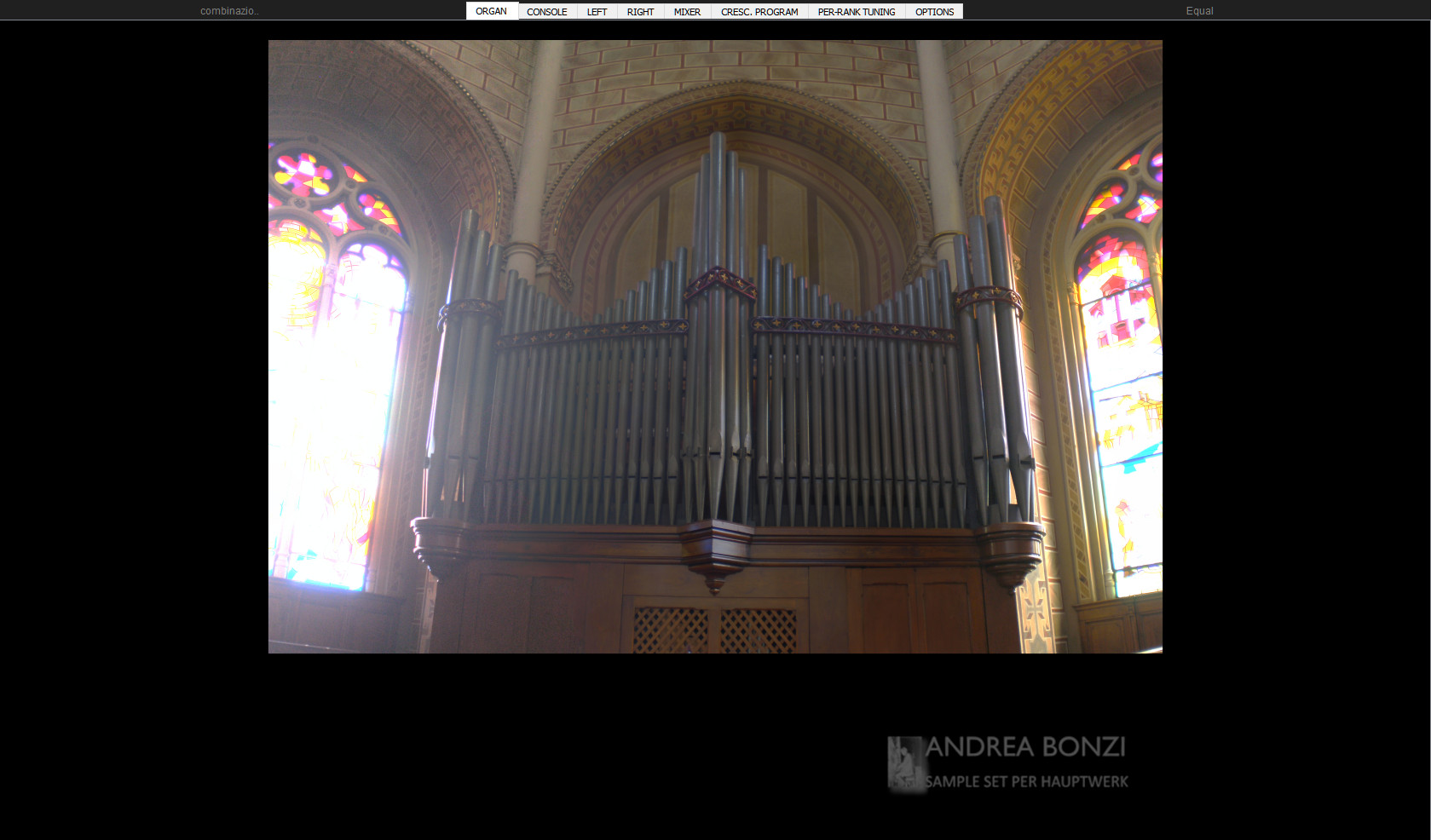
The facade of the Michelotto organ is reproduced, made up of the 8' Diapason pipes.
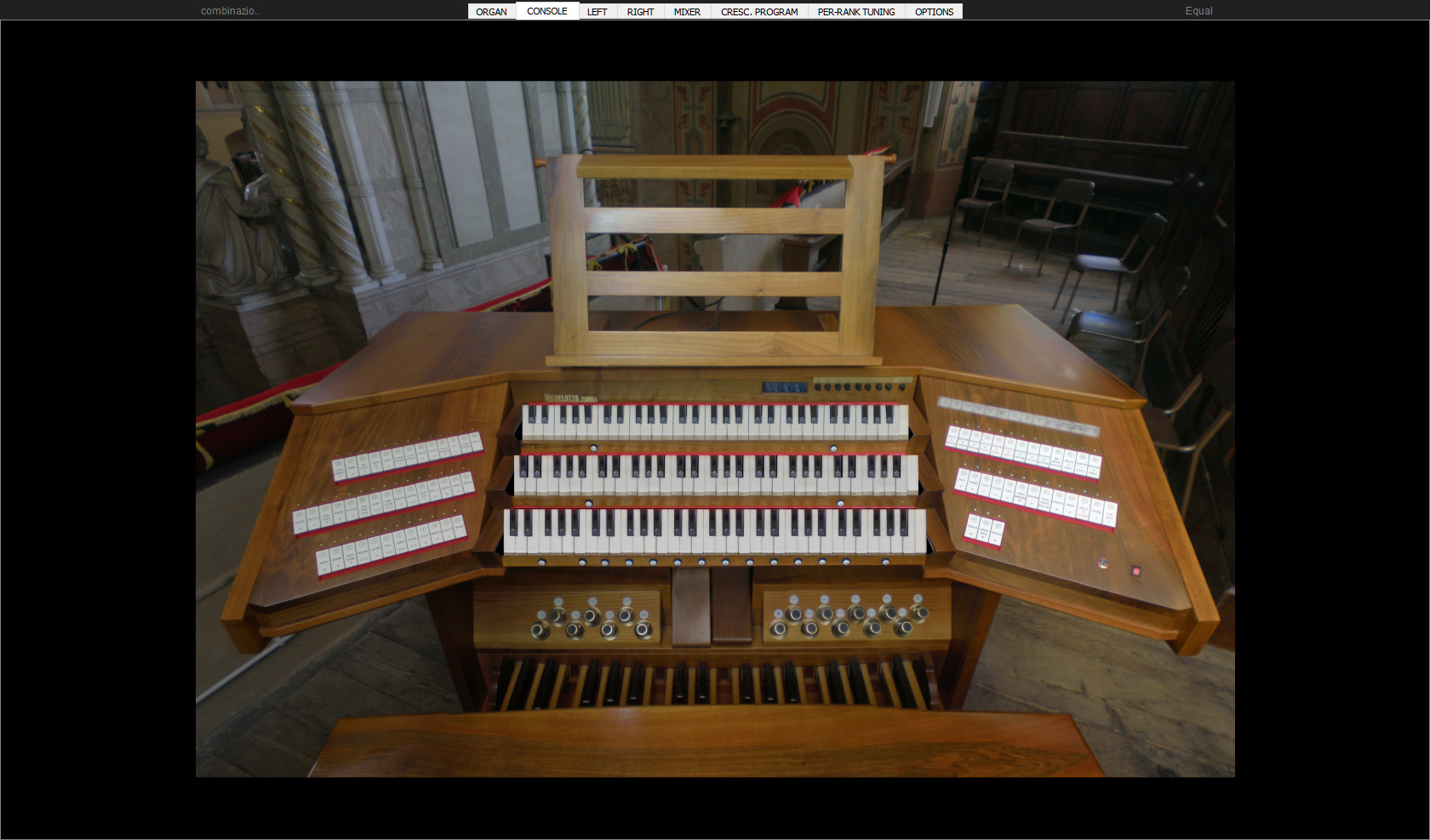
The Console panel is dedicated to the photographic reproduction of the Michelotto console, with simplified functions: from here the MIDI channels of keyboards and pedals can be assigned. The reproduction includes the movement of the Crescendo and Swell pedals and the lighting of the balance plate lights when the stops are inserted, which however cannot be directly controlled from this panel.
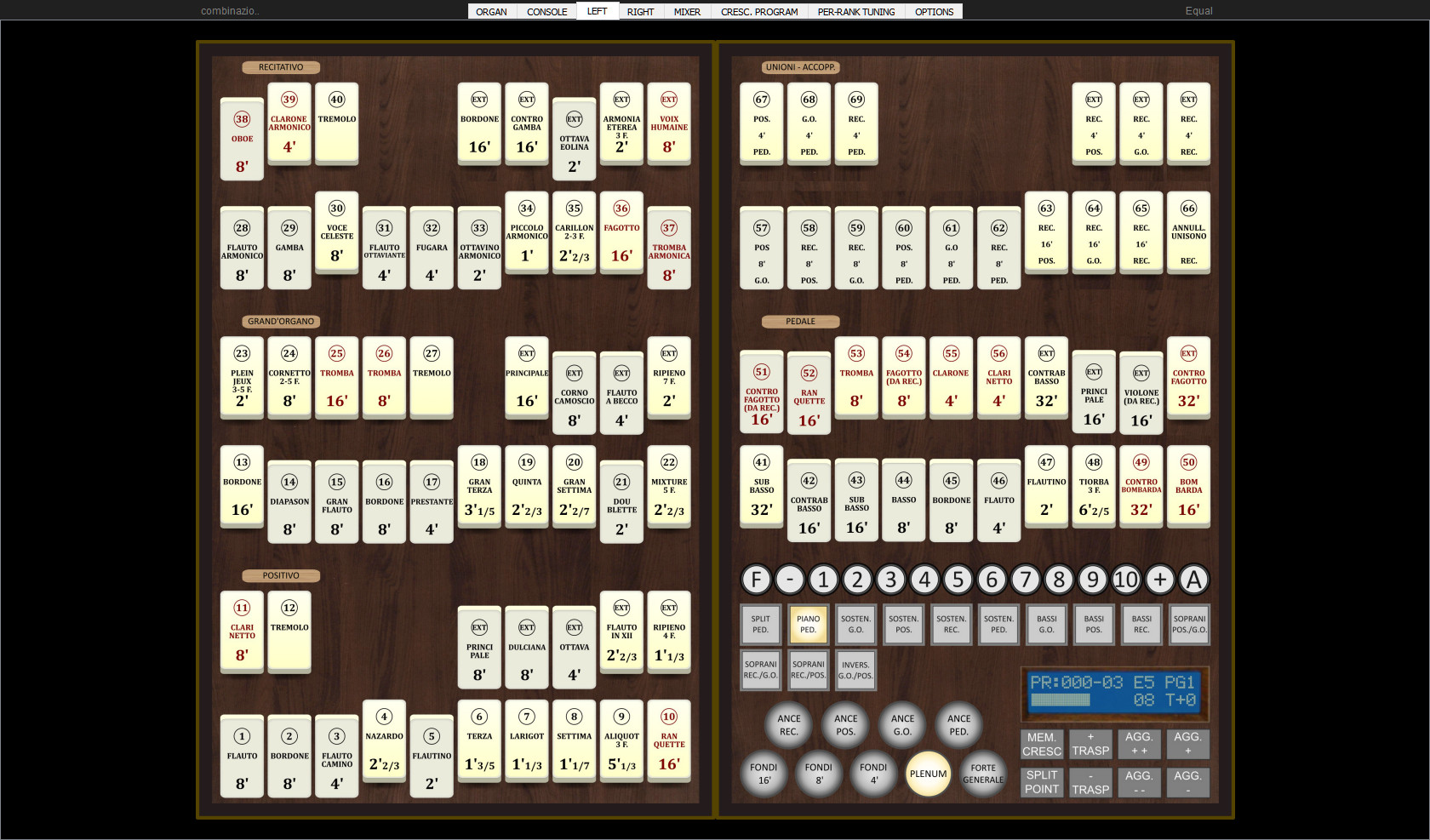
Also in this sample set the two LEFT and RIGHT panels are identical in the 4:3 format while in the 16:9 vertical format (or by appropriately resizing the windows) they reproduce the left and right parts respectively.
A graphic solution suitable for 16:9 monitors in horizontal format is still being studied, which will be implemented in future releases.
The arrangement of the plates has been designed to reproduce that of the Michelotto console, allowing at the same time to distinguish the extensions at a glance (highlighted by the acronym "EXT" which replaces the numbering of the original registers).
In the lower part of the right panel there are the commands that activate the different functions that the sample set - like the original pipes instrument - is equipped with.
Aggiustabili

The pistons for the combinations follow the layout of the Michelotto console, where they are located under the first manual: on the left and right, in addition to Setter and General Cancel, there are also the "+" and "-" buttons to move through a combination at a time in sequence.
Advanced console features

In the section below you will find the buttons for enabling the most advanced functions of the console, which in the original Michelotto are located above the third manual.
The functions have already been described in the section dedicated to the original pipes instrument to which we refer for further details: here We limit ourselves to a few clarifications.
The Piano Automatico al Pedale, which is activated when playing on the Positivo and Recitativo keyboards, only maintains the Subbasso 16', Bordone 8' and Unione Recitativo/Pedale stops if engaged.
We propose an explanatory video of the "SPLIT PEDALE" function, which shows how it works more effectively than a simple textual description:
The alphanumeric display reproduces exactly the one present above the third manual of the Michelotto console and provides the same indications.
From left to right and from top to bottom we have:
- Bank and number of the current combination
- Position of the expression pedal (from E1 to E5 indicating the current stage)
- Current program of the Crescendo (from PG1 to PG9, PG0 indicates the original Michelotto)
- Crescendo pedal indicator (horizontal bar and numbers from 0 to 10)
- Transposer (from T-4 to T+3)
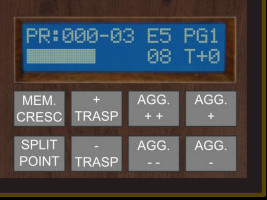
The small buttons below the display activate, from top to bottom and from left to right:
MEM CRESC. Cycles between the first 9 programmable memories of the Crescendo (see CRESC PROGRAM panel below) and the default setting.
SPLIT POINT. When SPLIT PEDALE is active, it allows you to set the division point by pressing a key on the pedalboard (the division remains stored upon subsequent loading of the sample set).
TRASP+, TRASP-. Transposer
AGG++, AGG--. Advancement and rewind of the combinations memory banks (from 0 to 99; by advancing or retreating a bank it is necessary to reselect the desired adjustable one)
AGG+, ADD-. Advancement and retreat of the combinations (from 0 to 10, with automatic advancement and retreat of the memory banks)
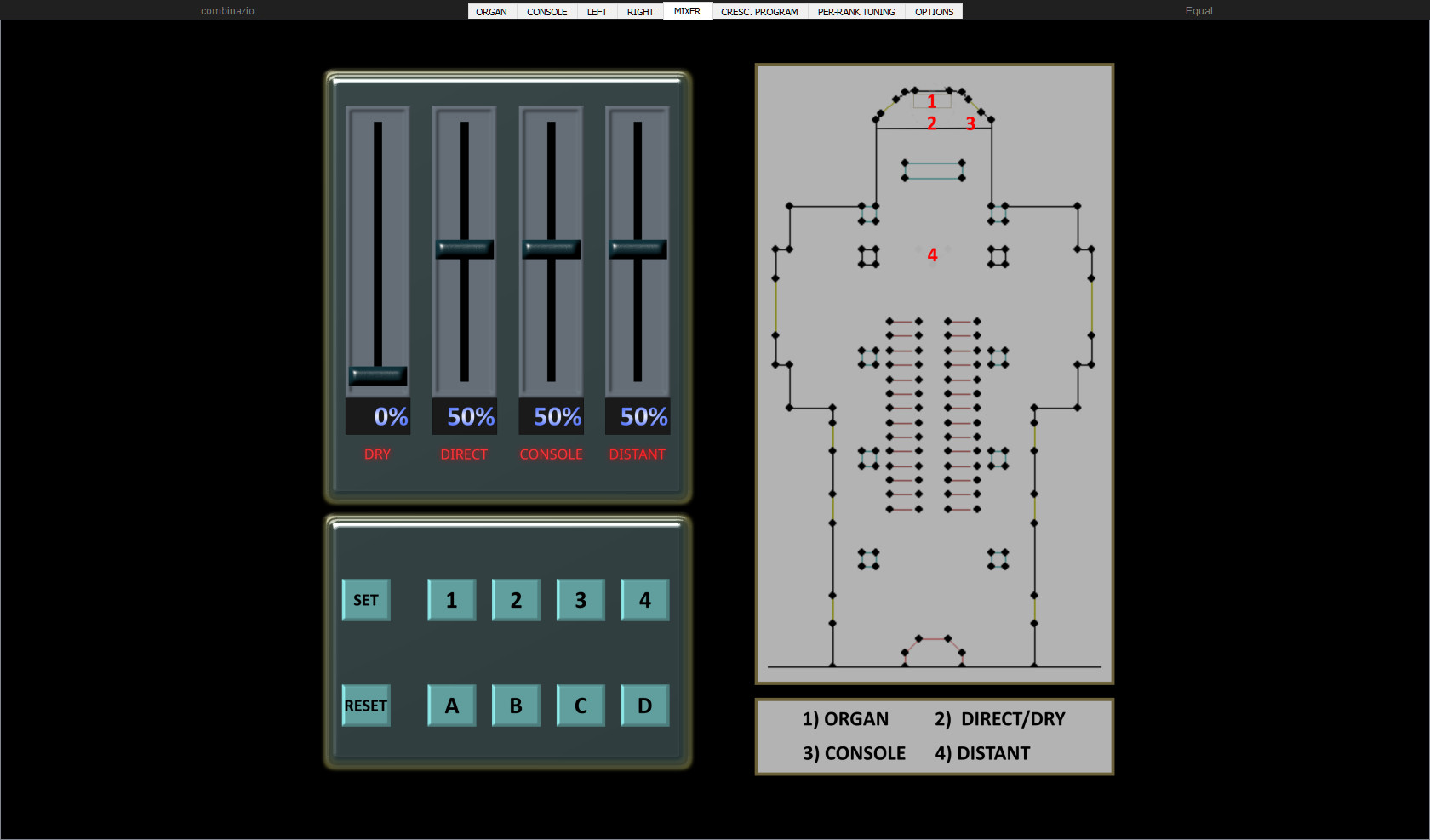
With this publication ANDREA BONZI - SAMPLE SET DI ORGANI ITALIANI offers for the first time a set equipped with four stereo channels: Dry, Direct, Console and Distant.
From the Mixer panel the user can adjust the relative volumes as desired: a legend indicates, on a stylized plan of the church, the position of the microphones for the Dry/Direct perspectives , Console and Distant.
The Mixer is equipped with a RESET button (which restores the default setting), four preset combinations (Presets A, B, C, D) and four assignable memories (1, 2, 3, 4).
Explanatory video of how the Mixer works:
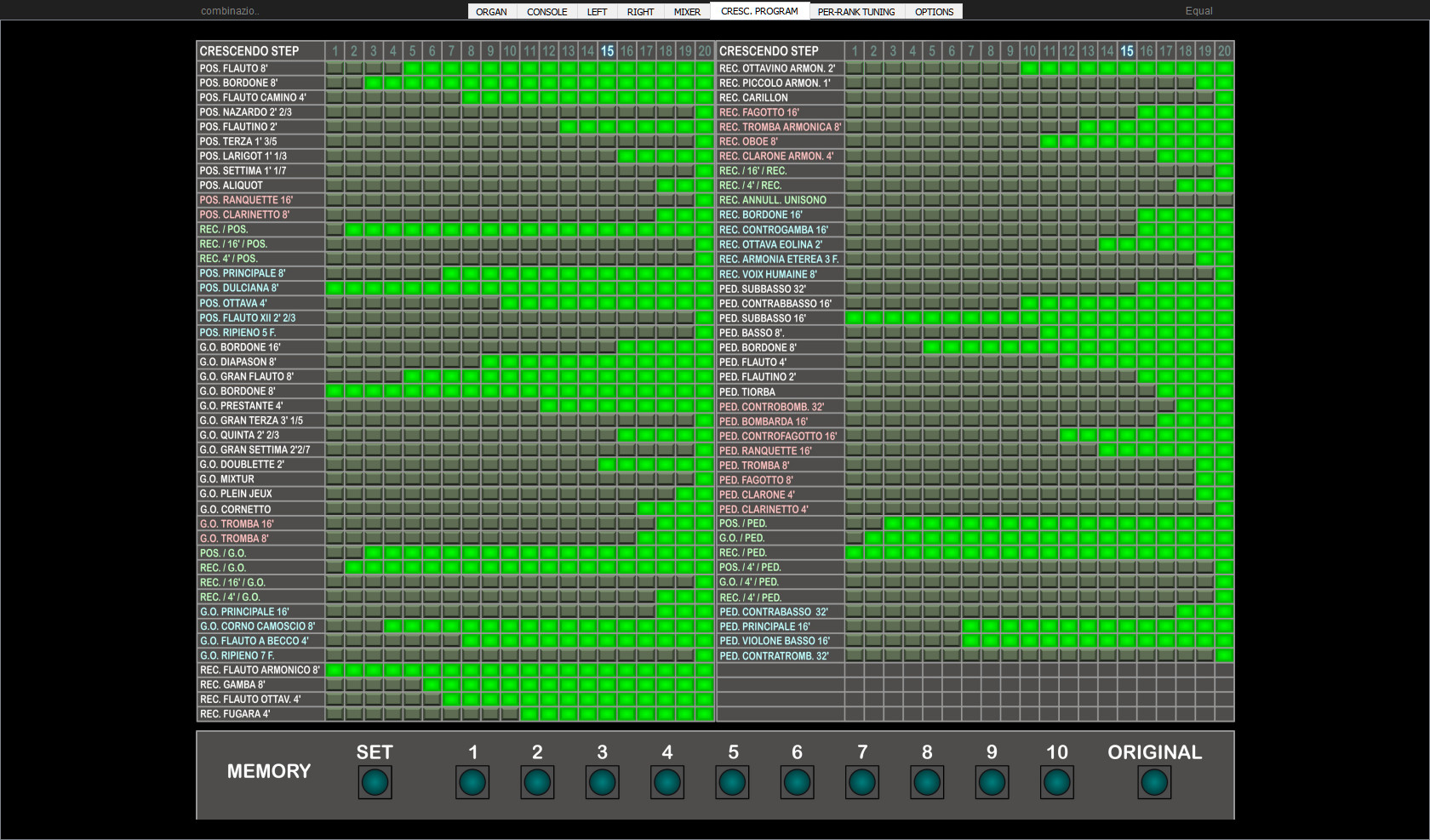
The Crescendo management panel has 21 programmable steps and 10 assignable memories, in addition to the default configuration which reproduces the 10 steps of the original Michelotto Crescendo. The "MEM. CRESC." button in the LEFT and RIGHT panels it allows you to cycle through the first 9 memories, exactly like in the Michelotto console.
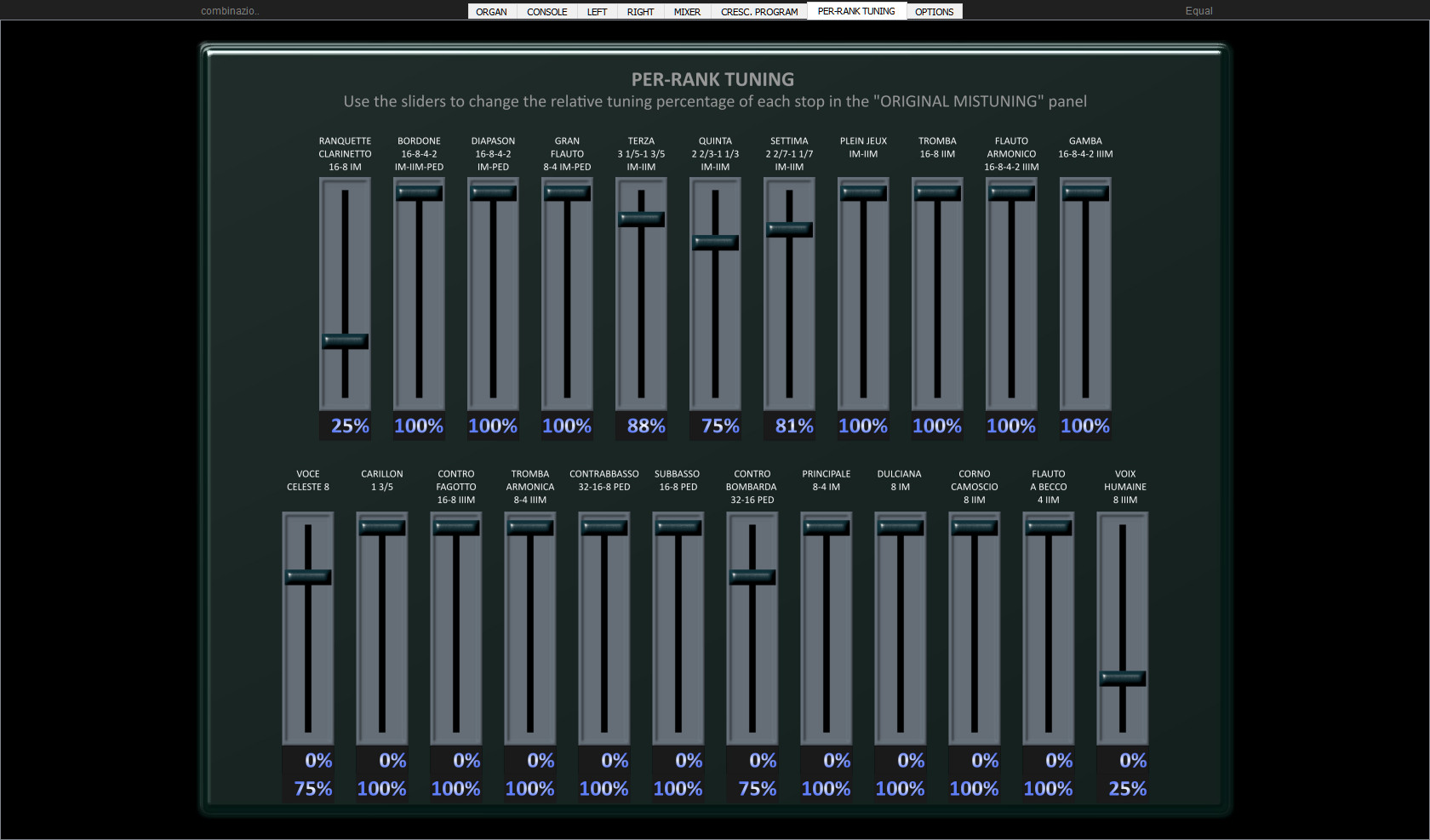
Given the notable differences in the precision of the tuning of the ranks during sampling, we considered it useful, on an experimental basis, to implement a panel dedicated to per-rank tuning, in which the cursors dedicated to the individual ranks act as limiters with respect to the two general sliders (for reeds and flue pipes) found in the Options panel.
Here is a video that demonstrates how it works when applied to the Ranquette/Clarinet:
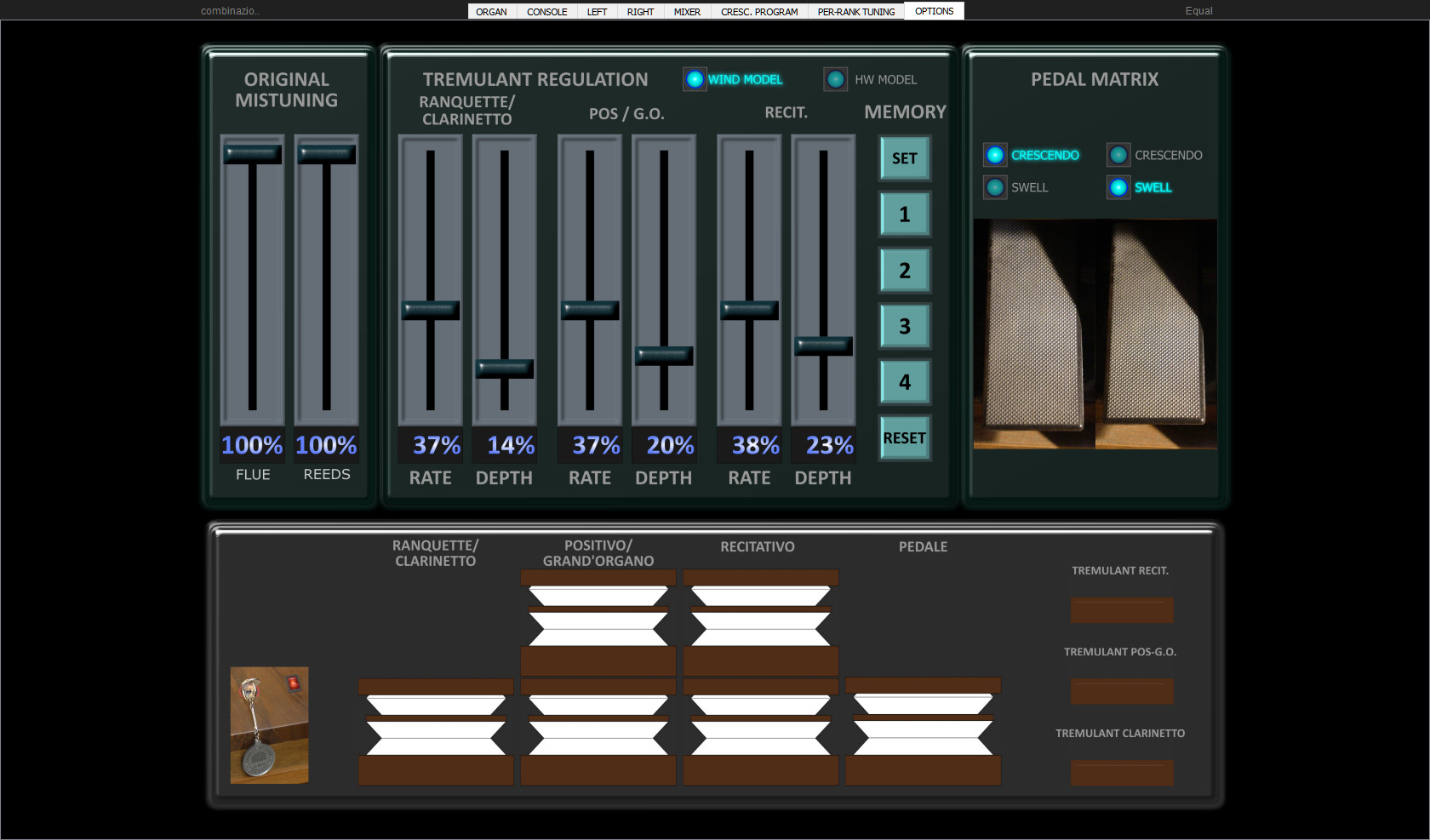
The Options panel is divided into sections that allow control of various sample set settings.
Detuning control
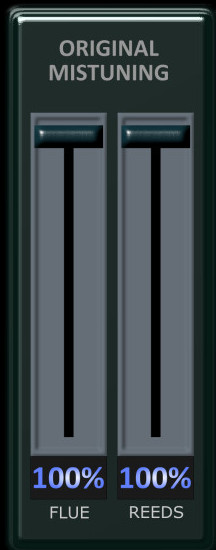 With this release we have introduced an important innovation in the tuning control on the user side: using the two sliders (for flue pipes and reeds) it is possible to switch from a perfect equal tuning (0%) to the original tuning of the pipe instrument during the sampling (100%). In this way it is possible to obtain maximum naturalness, without the introduction of artifices that surreptitiously (and inevitably less naturally) imitate the slight detunings already present in the samples.
With this release we have introduced an important innovation in the tuning control on the user side: using the two sliders (for flue pipes and reeds) it is possible to switch from a perfect equal tuning (0%) to the original tuning of the pipe instrument during the sampling (100%). In this way it is possible to obtain maximum naturalness, without the introduction of artifices that surreptitiously (and inevitably less naturally) imitate the slight detunings already present in the samples.
The level of detuning for the individual 100% ranks of the two cursors is controlled by the "PER-RANK TUNING" panel already described.
Considering the massive use of transmissions and extensions, even in intervals other than the octave, differently from our standard we have decided to disable the possibility of using temperaments other than equal.
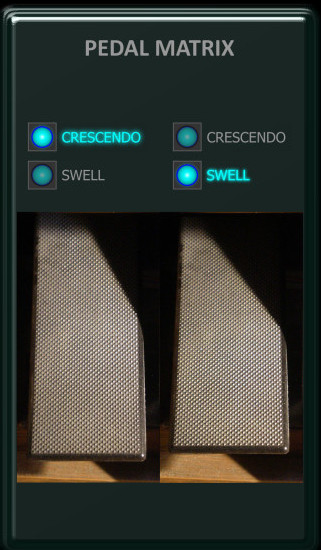
Pedal matrix
Another novelty of this publication is the possibility of assigning the pedals independently to Crescendo or Swell: so even with MIDI consoles equipped with a single pedal it is easy to switch from one to the other without having to reassign the MIDI controls.
Tremulants control panel
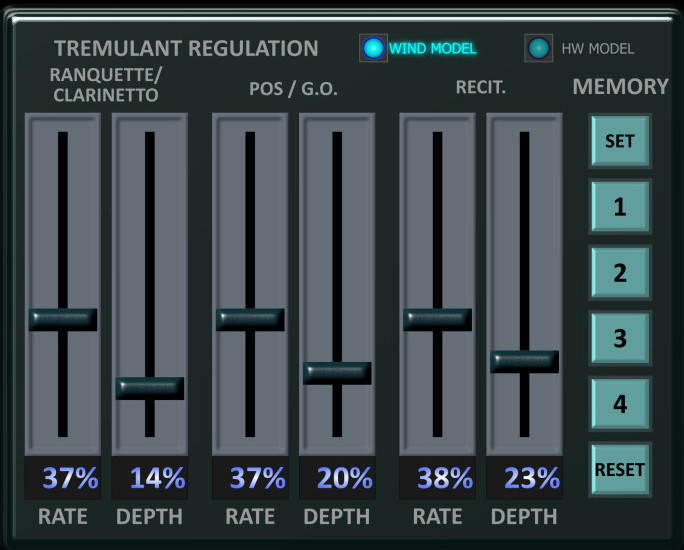
The sample set, like the original Michelotto pipes organ, has three Tremulants: one for Grand/organ and Positivo (single wind chest), one for the Recitative and an independent one for the Ranquette/Clarinetto, which is recalled together with that of Grand'Organo/Positivo.
The regulation of the Tremulants has been particularly studied: although it is still based on the Hauptwerk wind model, it has a completely redesigned internal motor to guarantee, on the user side, much more intuitive and reliable operation.
The two sliders available for each Tremulant regulate the frequency and depth of the beats respectively, in a wide range of values: as always, four programmable memories are available and a Reset which returns values as close as possible to those of the pipe instrument.
In addition to the Tremulant with the wind model, if desired, the one with the standard Hauptwerk model is available.
Video demonstration of the new Tremolo with wind model:
Sample set presentation concert:
We thank M° Roberto Lomurno for his collaboration
The demo version of the sample set for Hauptwerk 4.21 - 5 - 6 - 7 - 8 features a selection of stops according to the following stops list:
| POSITIVO | GRAND'ORGANO | RECITATIVO | PEDALE |
| BORDONE 8' | DIAPASON 8' | FLAUTO ARMONICO 8' | SUBBASSO 16' |
| FLAUTO CAMINO 4' | PRESTANTE 4' | FLAUTO OTTAVIANTE 4' | BORDONE 8'' |
| NAZARDO 2'2/3 | DOUBLETTE 2' | OTTAVINO ARMONICO 2' | FAGOTTO 8' |
| FLAUTINO 2' | PICCOLO ARMONICO 1' | ||
| OBOE 8' |
The range of accessories and functions is complete.
To download the demo, send a request via email using the button below:
Warning: do not change the subject of the message! The correct sending of the response containing the link to the sample-set depends on it.
If the sample set is deemed satisfactory, the full version can be requested after the trial period (please, carefully read the instructions in the email containing the link to the demo).
The sample set is offered at the launch price of euro 240.00, all inclusive, until March 31, 2024; from 1 April 2024 the price will be euro 300.00.
Please note: The fact that the payment for the sample set is intended directly for the parish of S. Maria does not allow us, at least for now, to rely directly on digital wallet payment systems such as Paypal, allowing bank transfer as the only method. Despite this limitation we preferred to proceed with a publication that has already been postponed many times; However, we are working towards a rapid implementation of other payment systems. We trust in users' patience.
Can't request the sample set or haven't received a response? Contact us by writing to:
